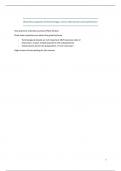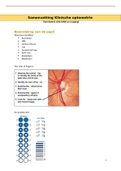Business aspects of technology: micro-electronics and photonics
Very practice-oriented course by Marie Gruber.
Most exam questions are about the guest lectures.
- Technological details are not important, BUT business side is!
- Oral exam, 2 open-ended questions with subquestions
- Closed book, 20 min for preparation, 15 min oral exam
High chance of succeeding for this course.
1
,Table of Contents
Week 1: Introduction + HBS game .........................................................................................4
1. Some general notes .................................................................................................4
Week 2: 8 domains of Photonics (by Francis Berghmans) .......................................................5
1. Photonics: Key enabling digital technology ................................................................5
2. Photonics: Durable economic driver for Europe ....................................................... 11
3. Innovator for SME’s ................................................................................................ 13
Week 3: Negotiations + NKT Photonics case study ............................................................... 19
1. Negotiations .......................................................................................................... 19
2. NKT photonics: case study (by Thomas Crispeels) ................................................... 23
Week 4: Innovation and history in fiber networks (by Stefano Beri)........................................ 28
1. Accessories for building a network infrastructure .................................................... 28
2. First generation of FO splice closures for long distance networks ............................. 29
3. Second generation of closures for access networks – single circuit fiber management
systems ......................................................................................................................... 31
4. Standards (IEC, ISO, ITU-T, CENELEC …) ................................................................. 34
5. The telecom bubble (2000-2002) ............................................................................ 40
6. Third generation products – fiber to the home (FttH) ................................................ 41
7. Latest trends and future ......................................................................................... 46
8. Lessons learned..................................................................................................... 47
Week 5: The micro-electronics industry (by Marc Goldchstein) ............................................ 48
1. The microelectronics industry .................................................................................... 48
2. Semiconductor business models ............................................................................... 65
3. The intel saga............................................................................................................. 69
4. Recent developments ................................................................................................ 74
5. Consumer electronics................................................................................................ 86
6. Quantum computing .................................................................................................. 90
Week 6: Academic business development and The Marlinks Story ....................................... 94
1. Academic business development (Arjen Van de Walle) ................................................ 94
1.1 Academic business development ....................................................................... 94
2
, 1.2 Introduction to business development ................................................................ 97
1.3 Academic business development ..................................................................... 103
1.4 Tactical business development in action ........................................................... 106
1.5 Conclusion ...................................................................................................... 109
2. The Marlinks story (Roel Vanthillo) ............................................................................ 110
Week 7: From Internet of Things (IoT) to Artificial Intelligence of Things (AIoT) and eXia ........ 116
1. From IoT to AIoT........................................................................................................ 116
1.1 IoT and AIoT ...................................................................................................... 116
1.2 AIoT system...................................................................................................... 119
1.3 AIoT applications .............................................................................................. 120
1.4 AIoT business models ....................................................................................... 126
1.5 AIoT supply chain actors ................................................................................... 128
1.6 AIoT standards ................................................................................................. 129
1.7 AIoT opportunities and challenges .................................................................... 130
2. The eXia story .......................................................................................................... 131
3
,Week 1: Introduction + HBS game
Not part of the exam.
1. Some general notes
Creative destruction – Joseph Schumpeter.
- Describes a process in which new innovations replace and make obsolete older
innovations.
- Bv. The camera by Sony: they saw big potential.
- Bv. Kodak filmrol: they couldn’t evoluate, victim of creative destruction.
Rapid prototyping approach AKA test and learn approach
- Needed in fast-changing environment
4
,Week 2: 8 domains of Photonics (by Francis Berghmans)
1. Photonics: Key enabling digital technology
Enabling: transforming our economy, generating new markets and players.
Digital technology: digital devices, systems and resources that help create, store, process,
transmit and manage data.
The economy of our present-day society is very much driven by knowledge and innovation
- Economy in Europe is driven by SME’s → we need to support SME’s to be able to absorb
technology and innovate
The processes of discovery, innovation, and digitization are currently enabled by 8 key digital
technologies:
- Photonics, advanced manufacturing, biotechnology, advanced materials,
nanotechnology, nanoelectronics, artificial intelligence and cyber security.
Photonics
= the science and technology that innovates with the unique properties of light. It encomp0
generating, guiding, manipulating, amplifying and detecting light.
- Photonics starts from the premise that “light is a tool”
Photonics: critical key-enabling technology for disruptive research and innovation
- Optical telecom
- Photovoltaics
- LED lighting
- Displays
- Optical components
- Medical optics
- Machine vision
- Lasers in manufacturing
Societal impact of photonics
No need to be present to see someone.
Photonics helped us through the COVID pandemic:
- Screening:
o Infrared thermometers
- Medical imaging
o Multispectral or fluorescence imaging
o Optical coherence tomography
5
, - Point-of-care diagnosis
o Real-time PCR (RT-PCR)
o Spectroscopy in development of vaccines
- Disinfection
o UV-C light sources
- Vaccine development
o Raman spectroscopy
- Communication and connectivity
o The internet is a photonics-driven engine: Panopto, canvac, teams, zoom, Netflix,
playstation…
- VUB realized a 10-fold increase in bandwidth in 2 years:
Data rate capacity in function of time:
1.1 Building our digital society
Photonics for a secure and resilient IT infrastructure
Our mission: zero downtime in a terabit economy
- If there is downtime, you are unable to do business → photonics helps with this
Cloud operators and datacenters face huge energy requirement challenges
- Data centers use more electricity than entire countries (bv. than Nigeria, Egypt,
Colombia)
- All data centers are consuming more and more energy:
The energy use remained quite constant thanks to
(innovation in) photonics, but internet traffic grew
exponentially
One of the most critical parameters in measuring the
performance of a High-Performance Computing or Data Center
interconnect is, the energy efficiency (measured in pJ/bit (pico
10-12 Joule) or mW/Gbps (milli Watt/GB per second).
6
, The optical fiber with its “limitless” bandwidth is being deployed to our homes: Fiber To The
Home (FTTX)
Fiber is already in cars:
- 150 MBit/s POF datacom transceivers are already deployed in our cars
- MOST-module by company Melexis
Fiber is also in aircraft: so we can watch movies on long flights
Optical parallel interconnects are envisioned to reach the core of our personal computer’s
microprocessors.
Photonic components and photonics circuitry are integrated on semiconductor chips. Support
is expected from the European Chips Act.
- PIC’s = photonics integrated circuits
7





